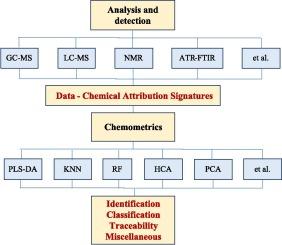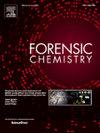Recent progress in the application of chemical attribution in forensic profiles
IF 2.6
3区 医学
Q2 CHEMISTRY, ANALYTICAL
引用次数: 0
Abstract
The utilization of chemical attribution technology could play a pivotal role in the collection of forensic evidence. By gathering and analyzing samples, it becomes possible to obtain characteristic chemical information that indicates their identity, thereby enabling the traceability of cases. This research strategy relies on analytical detection methods such as GC–MS, LC-MS, ATR-FTIR and NMR, as well as chemometrics to classify data. In recent years, it has been applied to the attribution research of many hazardous chemicals, which is of great significance in the field of chemical safety.

在法证剖析中应用化学归因的最新进展
利用化学鉴定技术可在收集法医证据方面发挥关键作用。通过收集和分析样本,可以获得表明其身份的特征化学信息,从而实现案件的可追溯性。这种研究策略依赖于分析检测方法,如 GC-MS、LC-MS、ATR-FTIR 和 NMR,以及对数据进行分类的化学计量学。近年来,它已被应用于许多危险化学品的归属研究,在化学品安全领域具有重要意义。
本文章由计算机程序翻译,如有差异,请以英文原文为准。
求助全文
约1分钟内获得全文
求助全文
来源期刊

Forensic Chemistry
CHEMISTRY, ANALYTICAL-
CiteScore
5.70
自引率
14.80%
发文量
65
审稿时长
46 days
期刊介绍:
Forensic Chemistry publishes high quality manuscripts focusing on the theory, research and application of any chemical science to forensic analysis. The scope of the journal includes fundamental advancements that result in a better understanding of the evidentiary significance derived from the physical and chemical analysis of materials. The scope of Forensic Chemistry will also include the application and or development of any molecular and atomic spectrochemical technique, electrochemical techniques, sensors, surface characterization techniques, mass spectrometry, nuclear magnetic resonance, chemometrics and statistics, and separation sciences (e.g. chromatography) that provide insight into the forensic analysis of materials. Evidential topics of interest to the journal include, but are not limited to, fingerprint analysis, drug analysis, ignitable liquid residue analysis, explosives detection and analysis, the characterization and comparison of trace evidence (glass, fibers, paints and polymers, tapes, soils and other materials), ink and paper analysis, gunshot residue analysis, synthetic pathways for drugs, toxicology and the analysis and chemistry associated with the components of fingermarks. The journal is particularly interested in receiving manuscripts that report advances in the forensic interpretation of chemical evidence. Technology Readiness Level: When submitting an article to Forensic Chemistry, all authors will be asked to self-assign a Technology Readiness Level (TRL) to their article. The purpose of the TRL system is to help readers understand the level of maturity of an idea or method, to help track the evolution of readiness of a given technique or method, and to help filter published articles by the expected ease of implementation in an operation setting within a crime lab.
 求助内容:
求助内容: 应助结果提醒方式:
应助结果提醒方式:


